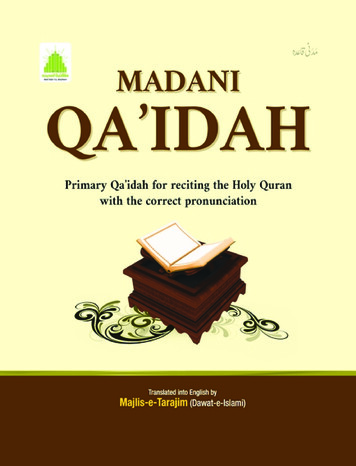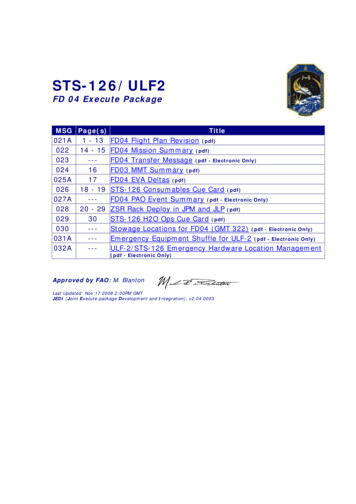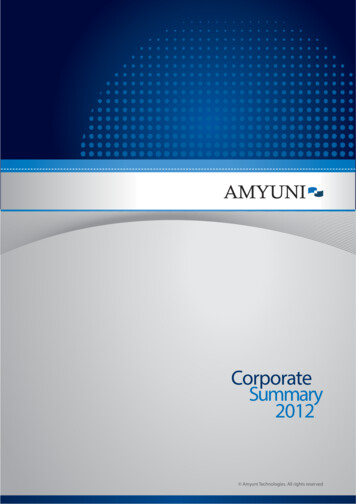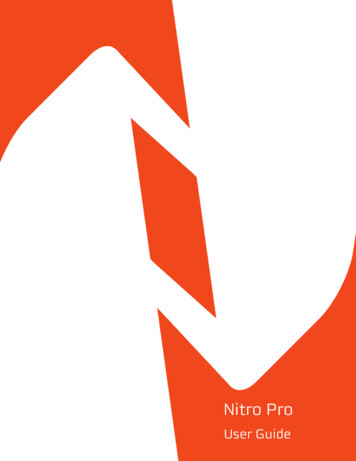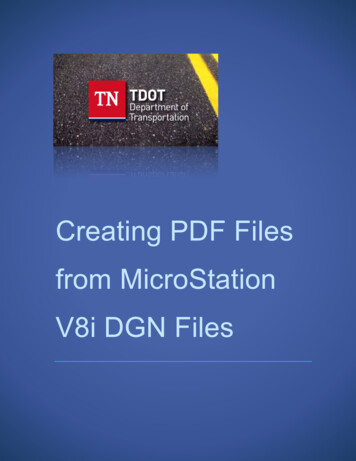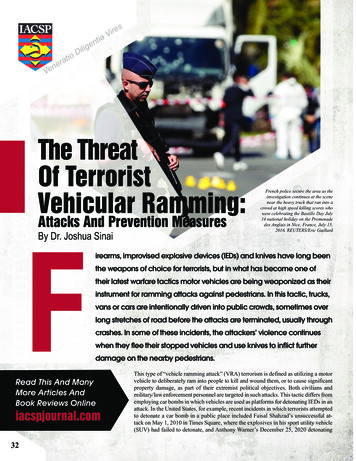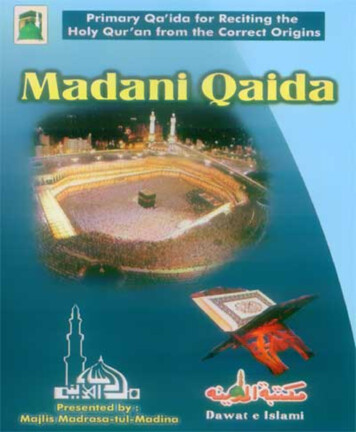
Transcription
MADANI QA’IDAHArticulatory organs of the lettersThe literal meaning of the word Makhraj is the point of outlet. In terms of Tajwīd thearticulatory organ of an Arabic letter is called Makhraj (articulator).Letters ﻩ , ء ح , ع خ , غ ق ك ی , ش , ج ض ر , ن , ل ط , د , ت ظ , ذ , ث ص , س , ز ف ب م و CategoryArticulatorḤalqiyyaĥ LettersPronounced from the bottom part of the throat“ ”Pronounced from the middle part of the throat“ ”Laĥawiyyaĥ Letters“ ”Shajariyyaĥ LettersḤāfiyāĥ LetterṬarafiyyaĥ LettersNiṭ’iyyaĥ LettersLišawiyyaĥ LettersṢafīriyaĥ LettersShafawiyyaĥ LettersPronounced from the top part (pharynx) of thethroatPronounced from the root of the tongue and thesoft palatePronounced from the root of the tongue and thehard palatePronounced from the middle of the tongue andthe middle of the palatePronounced from the sides of the tongue andthe roots of the upper molarsPronounced from the edge of the tongue and thepart of the roots of the teeth towards the palatePronounced from the tip of the tongue and theroots of the upper front teethPronounced from the top of the tongue and theinner edge of the upper teethPronounced from the tip of the tongue and theinner edges of both (front-upper) teethPronounced from the edge of the upper front teethand the wet part of the lower lip“ ”Pronounced from the wet part of both lips“ ”Pronounced from the dry part of both lips“ ”Pronounced by the rounding of both lips
َﻣ َﺪﻧِﯽ ﻗﺎ ِﻋ َﺪہ MADANI QA’IDAHPrimary Qā’idaĥ for reciting the Holy Quranwith correct articulationPresented byMajlis Madrasa-tul-MadinahTranslated into English byMajlis-e-Tarajim (Dawat-e-Islami)
An English translation of ‘Madani Qa’idah’ ALL RIGHTS RESERVEDCopyright 2014 Maktaba-tul-MadinahNo part of this publication may be reproduced, or transmitted, in any form or by any means,electronic, mechanical, photocopying, recording or otherwise, without the prior writtenpermission of Maktaba-tul-Madinah.Edition:stFirst1 Publication:Rajab-ul-Murajjab, 1435 AH – (May, onsorshipFeel free to contact us if you wish to sponsor the printing of a religious book or booklet for theIsal-e-Sawab of your deceased family members.Maktaba-tul-MadinahAalami Madani Markaz, Faizan-e-Madinah Mahallah Saudagran,Purani Sabzi Mandi, Bab-ul-Madinah, Karachi, Pakistan Email: maktabaglobal@dawateislami.net - maktaba@dawateislami.net Phone: 92-21-34921389-93 – 34126999 Web: www.dawateislami.net
ٰۡۡ ٰ ۡ ٰ ۡ ٰ ۡ ۡ ! " ۡ ! ٰ ٰٰ ۡ ۡ ۡ % ,-ۡ ." () ,- ۡ 0" ( ٰ 0ۡ " / * ( # % & ۡ # ' % # Du’ā for Reading the BookRead the following Du’ā (supplication) before you study a religious book or an Islamiclesson, you will remember whatever you study, :َ َ ۡ َ ۡ َّ ُ ّٰ ََ ََ َۡۡۡ ك َوان ۡ ُش حكمت ِ اللهم افتح علينا ۡ ۡ َ َ َۡ َ َ َ َ َ ۡ َ َ ۡ َ ََ ِكرام # ِل وا % علينا رحتك يـا ذا ال (Rūḥānī Ḥikāyāt, pp. 68)Note: Recite Ṣalāt-‘Alan-Nabī once before and after the Du’ā.Madanī objectiveI must strive to reform myself and the people of the entire world, .Name:Madrasaĥ:Class:Address:Phone number:iii
Transliteration Chart ء ا ب پ ت ٹ ث ج چ ح خ د ڈ ذ /ḋŻ/ż ڑ ز ژ س ش ص ض ط ظ ع غ ف ق ك Gh/ghF/fQ/qK/kiv ل م ن M/m و V/v, W/w ۃ / ہ / ھ ى ے َ ُ ِ و ﻣ ّﺪہ ى ﻣ ّﺪہ ا ﻣ ّﺪہ L/lN/nĤ/ĥY/yY/yA/aU/uI/iŪ/ūĪ/īĀ/ā
ٰۡۡ ٰ ۡ ٰ ۡ ٰ ۡ ۡ ! " ۡ ! ٰ ٰٰ ۡ ۡ ۡ % ,-ۡ ." () ,- ۡ 0" ( ٰ 0ۡ " / * ( # % & ۡ # ' % # Translator’s NotesDear Islamic brothers! Dawat-e-Islami’s Majlis-e-Tarājim, a department responsible forreproducing the books and booklets of Amīr-e-Aĥl-e-Sunnat founder of Dawat-e-Islami‘Allāmaĥ Maulānā Abu Bilal Muhammad Ilyas Attar Qadiri Razavi ! " #into various languages of the world, is pleased to deliver English version of the book‘Madanī Qā’idaĥ’ which was presented in Urdu language by Majlis Madrasa-tul-Madīnaĥto impart basic knowledge for correct recitation of the Holy Quran. To facilitate thepronunciation of Arabic letters, a transliteration chart has been added.This translation has been accomplished by the grace of Almighty Allah , by the favourof His Noble Prophet ٖ & ' & ( ) and the spiritual support of our great Shaykh, thefounder of Dawat-e-Islami, ‘Allāmaĥ Maulānā Abu Bilal Muhammad Ilyas Attar QadiriRazavi ! " #. If there is any shortcoming in this work, it may be a human erroron the part of the Translation Majlis. Therefore, if you find any mistake in it, kindly notifyus in writing at the following postal or email address with the intention of earning reward(Šawāb).Majlis-e-Tarājim (Translation Department)Aalami Madani Markaz, Faizan-e-Madinah Mahallah Saudagran,Purani Sabzi Mandi, Bab-ul-Madinah, Karachi, PakistanPhone: 92-21-111-25-26-92 – Ext. 1262Email: translation@dawateislami.netv
ٰۡۡ ٰ ۡ ٰ ۡ ٰ ۡ ۡ ! " ۡ ! ٰ ٰٰ ۡ ۡ ۡ % ,-ۡ ." () ,- ۡ 0" ( ٰ 0ۡ " / * ( # % & ۡ # ' % # First read thisHoly Quran, the Word of Allah is a matchless source of guidance, knowledge and )wisdom. The Most Beloved Prophet ٖ & * ' & ( said:َ َّ َ َ َ ٰ ُ َّۡ َ َ ۡ َ ۡ ُ ُ ۡ َ خيكم من تعل َم الق ۡران وعلم ٗه The best person amongst you is he who learnt the Holy Quran and taught to others.(Ṣaḥīḥ Bukhārī, Kitāb Faḍāil-ul-Quran, pp.435, Ḥadīš 5027) , -. !In order to spread the teachings of the Holy Quran, Dawat-e-Islami, thenon-political global movement for the propagation of the Holy Quran and Sunnaĥ hasestablished countless Madāris (schools) titled Madrasa-tul-Madīnaĥ in Pakistan andabroad. These Madāris hold classes of Ḥifẓ and Nāẓiraĥ. To date, approximately 72,000Madanī children are being taught Ḥifẓ and Nāẓiraĥ for free in Pakistan. Similarly,Madrasa-tul-Madīnaĥ classes (for male adults) are held in various Masājid etc. almostdaily after Ṣalāt-ul-‘Ishā’. Islamic brothers learn the correct recitation of the Holy Quran,pronouncing the Arabic letters from their proper articulators (Makhārij), Du’ās(supplications), Ṣalāĥ and the Sunan, all for free. In addition, thousands of Madrasa-tulMadīnaĥ classes (for female adults) are held daily within the homes not just in Pakistan,but also in several other countries of the world. As an example, to date, approximately1,317 Madrasaĥ classes for Islamic sisters take place almost on a daily basis in Bāb-ulMadīnaĥ (Karachi), in which more than 12,017 Islamic sisters learn the Holy Quran, Ṣalāĥ,Sunan and Du’ās, all for free. vi
Madani Qai’dah , -. !The experienced teachers of Madrasa-tul-Madīnaĥ have compiled this MadanīQā’idaĥ to make learning of the Holy Quran easier. The Madanī Qā’idaĥ presents thefundamental rules of Tajwīd (elocution) in a simplified form for both the young and theaged students, so that all children, Islamic brothers and Islamic sisters may easily learnthe correct recitation of the Holy Quran. Expert Qurrā (reciters of the Holy Quran) 0 1' & / have carefully checked and verified the contents of the Madanī Qā’idaĥ withregards to the rules of Tajwīd.For guidance on how to teach the Madanī Qā’idaĥ, the book named ‘Raĥnumā-eMudarrisīn’ (a guide book) has also been published; it contains a great deal of the teachingmethodology for each lesson. The V.C.D. of the Madanī Qā’idaĥ will also be released verysoon by Maktaba-tul-Madīnaĥ, a department of Dawat-e-Islami ; it will befurther helpful in understanding the Madanī Qā’idaĥ thereby making the recitation of theHoly Quran easier.As per our Madanī objective set out by Amīr-e-Aĥl-e-Sunnat, the founder of Dawat-eIslami, ‘Allāmaĥ Maulānā Abu Bilal Muhammad Ilyas Attar Qadiri Razavi ! " #:‘I must strive to reform myself and the people of the entire world, ’, mayAllah make us act upon the Madanī In’āmāt for reforming ourselves and make ustravel with the Madanī Qāfilaĥs for reforming the people of the entire world!ٰ َ ٰ َ ُ ّٰ َّ ََّ ت َعا َعل ۡيهِ َوا ِلٖ َو َسلم 9 ا صل ۡ َ ۡ ّ َّ َ ۡ ٰ ِمي # ب ا ِ ِ ا ِمي ِباه ِ ال Majlis Madrasa-tul-Madīnaĥ (Dawat-e-Islami)29th Żul-Ḥijja-til-Ḥarām 1428Hvii
َﻣ َﺪﻧِﯽ ﻗﺎ ِﻋ َﺪہ MADANIQA’IDAHviii
,- ۡ 0" ( ٰ 0ۡ " ٰ ٰٰ ۡ ۡ ۡ ۡ ۡ ٰ ٰ ۡ ٰ ۡ ٰ ۡ ۡ ۡ % ,-ۡ . " () / * ( # % & ۡ # ' % # ! " ! Lesson Number 1: Ḥurūf Mufridāt (Individual Letters)CThe Mufridāt Letters i.e. Arabic alphabets are 29 in number. C Pronounce MufridātLetters with the Arabic accent according to the rules of Tajwīd and Qirā at, avoidUrdu pronunciations, for example do not pronounce: ‘ ﻇﻮﺋﮯ , ﻃﻮﺋﮯ , ﺧﮯ , ﺣﮯ , ﺛﮯ , ﺗﮯ , ’ﺑﮯ .Instead pronounce them in the following way: ‘ ﻇَﺎ , ﻃَﺎ , ﺧﺎ َ , َﺣﺎ , ﺛ َﺎ , ﺗَﺎ , ’ﺑَﺎ CFrom amongst these 29 letters, there are 7 that are always pronounced with athicker voice, these letters are called ‘Musta’liyaĥ Letters’. These seven letters are:َّ ’ﺧ . C Only‘ خ , ص , ض , ط , ظ , غ , ’ق . Their combination (as a mnemonic) is: ‘ ﺿ ْﻐ ٍﻂ ِﻗـ ْﻆ َ ُﺺ 4 letters are pronounced from the lips: ب , ف , م , و . Except these letters, do not let thelips move whilst pronouncing any other letter.1
Madani Qai’dahٰۡۡ ٰ ۡ ٰ ۡ ٰ ۡ ۡ ! " ۡ ! ٰ ٰٰ ۡ ۡ ۡ % ,-ۡ ." () ,- ۡ 0" ( ٰ 0ۡ " / * ( # % & ۡ # ' % # Lesson Number 2: Ḥurūf Murakkabāt (Compound Letters)CTwo or more letters combine to form a Murakkab (Compound). C Pronounce eachletter of the Murakkab letters separately like Mufridāt Letters.CMake sure in this lesson also to pronounce the letters in the Ma’rūf manner i.e. withthe Arabic accent.CWhen two or more letters are joined together in writing, their shape gets changed abit. Usually the head of the letter is written and the body is omitted. C The letterswhich are identical when in the compound form, identify them by the difference inthe number and position of the dots.2
Madani Qai’dah3
Madani Qai’dahٰۡۡ ٰ ۡ ٰ ۡ ٰ ۡ ۡ ! " ۡ ! ٰ ٰٰ ۡ ۡ ۡ % ,-ۡ ." () ,- ۡ 0" ( ٰ 0ۡ " / * ( # % & ۡ # ' % # Lesson Number 3: ḤarakātCThe plural of Ḥarakat is ‘Ḥarakāt’. Zabar, Zayrand Payshare calledḤarakāt. Zabar and Paysh are placed above the letters whereas Zayr is placed underneath.CThe letter which bears Ḥarakat is called ‘Mutaḥarrik’.4
Madani Qai’dahCPronounce Zabarby opening the mouth and raising the voice, Zayrdropping the voice and Payshby the rounding of the lips.CPronounce the Ḥarakāt in Arabic accent without stretching or jerking the voice.CIf a Ḥarakat or Jazm is present on ‘ ’ا َﻟِﻒ then pronounce it as Ĥamzaĥ ‘ , ’.CbyIf the letter ‘ ’را carries a Zabar or Paysh pronounce it with a thick tone. If the letter‘ ’را bears a Zayr, pronounce it with a thin tone.5
Madani Qai’dah6
Madani Qai’dahٰۡۡ ٰ ۡ ٰ ۡ ٰ ۡ ۡ ! " ۡ ! ٰ ٰٰ ۡ ۡ ۡ % ,-ۡ ." () ,- ۡ 0" ( ٰ 0ۡ " / * ( # % & ۡ # ' % # Lesson Number 4CRead this lesson Rawān (i.e. without syllabification).CTake special care to pronounce Ḥarakāt correctly.CDifferentiate clearly between the letters that are Qarīb-uṣ-Ṣaut i.e. the letters thatsound somewhat similar.7
Madani Qai’dah ﲑ ُ ْ َﻳﺎ َﺧ ِﺒ To become pious and to abide by Sunnaĥ, keep invoking it all the time.(Masāil-ul-Quran pp. 290)8
Madani Qai’dahٰۡۡ ٰ ۡ ٰ ۡ ٰ ۡ ۡ ! " ۡ ! ٰ ٰٰ ۡ ۡ ۡ % ,-ۡ ." () ,- ۡ 0" ( ٰ 0ۡ " / * ( # % & ۡ # ' % # Lesson Number 5: TanwīnCDouble Zabar, double Zayrand double Payshis called ‘Tanwīn’.A letter carrying Tanwīn is called Munawwan.CIn fact Tanwīn is a ‘Nūn Sākin’ that lies at the end of the phrase, that is why Tanwīnsounds like ‘Nūn Sākin’, e.g. ‘ ن ْ َ ا ,C ن ْ ُ ’ا ِﻣ ْٓﻴﻢ double Zabar َﻣ ْﻦ ,Spell out the examples of Tanwīn as follows:double Zayr ﻦ ْ ِﻣ ,C ن ْ ِ ا , ِﻣ ْٓﻴﻢ double Paysh ﻦ ْ ُﻣ , ِﻣ ْٓﻴﻢ ,Sometimes ‘ ’ا or ‘ ’ی is shown after double Zabar, do not pronounce it duringsyllabification.9
Madani Qai’dah10
Madani Qai’dahٰۡۡ ٰ ۡ ٰ ۡ ٰ ۡ ۡ ! " ۡ ! ٰ ٰٰ ۡ ۡ ۡ % ,-ۡ ." () ,- ۡ 0" ( ٰ 0ۡ " / * ( # % & ۡ # ' % # Lesson Number 6CRead this lesson both ways i.e. Rawān (without syllabification) as well with Ḥijjay(with syllabification).CTake special care to correctly pronounce Ḥarakāt, Tanwīn and all the lettersparticularly the Ḥurūf Musta’liyaĥ.CDo Ḥijjay in this way: ِﻣ ْٓﻴﻢ Zabar.11, َﻵم Zayr ل ِ , ﲝۤف . double Paysh
Madani Qai’dahٰۡۡ ٰ ۡ ٰ ۡ ٰ ۡ ۡ ! " ۡ ! ٰ ٰٰ ۡ ۡ ۡ % ,-ۡ ." () ,- ۡ 0" ( ٰ 0ۡ " / * ( # % & ۡ # ' % # Lesson Number 7The Letters of MaddaĥThis signis called Jazm. A letter that carries a Jazm is called Sākin (stationary).CCThe Sākin letter is read along with the Mutaḥarrik letter preceding it.CThere are three letters of Maddaĥ, these are: ا َﻟ ِْﻒ , َوآو , َﻳﺎ CWhen there is Zabar before ا َﻟ ِْﻒ , it becomes ‘ ا َﻟ ِْﻒ Maddaĥ’ e.g. َﺑﺎ . When there is Payshbefore َوآو Sākin ( ) ْو , it becomes ‘ َوآو Maddaĥ e.g.Sākin ( ی ْ ), it becomes ‘ َﻳﺎ Maddaĥ e.g. When there is Zayr before َﻳﺎ .CPronounce the letters of Maddaĥ by elongating them up to one ِﻒ ْ ا َﻟ i.e. up to twoḤarakāt.CSpell out as: ا َﻟ ِْﻒ َﺑﺎ Zabar, َوآو َﺑﺎ Paysh12, َﻳﺎ َﺑﺎ Zayr ,,.
Madani Qai’dah13
Madani Qai’dahٰۡۡ ٰ ۡ ٰ ۡ ٰ ۡ ۡ ! " ۡ ! ٰ ٰٰ ۡ ۡ ۡ % ,-ۡ ." () ,- ۡ 0" ( ٰ 0ۡ " / * ( # % & ۡ # ' % # Lesson Number 8Kĥařī [Vertical] ḤarakātCVertical Zabar[vertical] Ḥarakāt., vertical ZayrCThe vertical Ḥarakāt are equivalent to the letters of Maddaĥ. So pronounce verticaland inverted Payshare called KĥařīḤarakāt by elongating them up to one ا َﻟ ِْﻒ i.e. up to two Ḥarakāt, like that in the caseof the letters of Maddaĥ.CIn this lesson, differentiate clearly between the letters that are Qarīb-uṣ-Ṣaut i.e. theletters that sound somewhat similar.14
Madani Qai’dah15
Madani Qai’dahٰۡۡ ٰ ۡ ٰ ۡ ٰ ۡ ۡ ! " ۡ ! ٰ ٰٰ ۡ ۡ ۡ % ,-ۡ ." () ,- ۡ 0" ( ٰ 0ۡ " / * ( # % & ۡ # ' % # Lesson Number 9The Letters of LīnCThere are two letters of Līn: ‘ ’ َوآو and ‘ ’ َﻳﺎ CWhen there is Zabar before َوآو Sākin, it becomes ‘ َوآو Līn’ e.g.Zabar before َﻳﺎ Sākin, then it becomes ‘ َﻳﺎ Līn’ e.g. When there is.CPronounce the letters of Līn gently in Arabic accent without any elongation.CSpell out in this way: َوآو َﺑﺎ Zabar,16 َﻳﺎ َﺑﺎ Zabar ,.
Madani Qai’dah17
Madani Qai’dahٰۡۡ ٰ ۡ ٰ ۡ ٰ ۡ ۡ ! " ۡ ! ٰ ٰٰ ۡ ۡ ۡ % ,-ۡ ." () ,- ۡ 0" ( ٰ 0ۡ " / * ( # % & ۡ # ' % # Lesson Number 10CRead this lesson both ways i.e. Rawān as well with Ḥijjay.CThis lesson comprises of all the previous lessons i.e. Ḥarakāt, Tanwīn, the Letters ofMaddaĥ, Vertical Ḥarakāt and the Letters of Līn.CApply the rules, practise recognition of the letters and spell them out correctly,especially Ḥurūf Musta’liyaĥ.CWhilst doing Ḥijjay, join every letter to the preceding letters. For example do Ḥijjayof the wordas follows َوآو ِﻣ ْٓﻴﻢ Zabar َ ْٓﲔ 5 Zabar َ ع , َﺗﺎ double Paysh ٌ ة 18., ﺿﺂد َ َوآو Paysh ,
Madani Qai’dah19
Madani Qai’dahٰۡۡ ٰ ۡ ٰ ۡ ٰ ۡ ۡ ! " ۡ ! ٰ ٰٰ ۡ ۡ ۡ % ,-ۡ ." () ,- ۡ 0" ( ٰ 0ۡ " / * ( # % & ۡ # ' % # Lesson Number 11Sukūn (Jazm)is called Jazm, a letter carrying Jazm isCAs you have already learnt, this signcalled Sākin (still letter).CThe letter carrying Jazm is pronounced in conjunction with the Mutaḥarrik letterpreceding it.CAlways pronounce the Ĥamzaĥ Sākinaĥ ( , ) with jerk.CThere are five Letters of Qalqalaĥ ق , ط , ب , ج , د , their combination is ﺐ َﺟ ّ ٍﺪ ُ ﻗُـ ُﻄ .CThe meaning of Qalqalaĥ is movement, there should be somewhat movement at theMakhārij (articulator) when pronouncing these letters such that the sound rebounds.CWhen the Letters of Qalqalaĥ are Sākin, Qalqalaĥ should be more prominent.CIn this lesson, take special care for correct pronunciation of the Letters of Qalqalaĥand the Ĥamzaĥ Sākinaĥ and distinguish clearly between the letters that soundsomewhat similar.20
Madani Qai’dah21
Madani Qai’dahZayr is notused before‘ ’وآو َ SākinPaysh is notused before‘ ’ﻳﺎ َ SākinEXERCISE22
Madani Qai’dah23
Madani Qai’dahٰۡۡ ٰ ۡ ٰ ۡ ٰ ۡ ۡ ! " ۡ ! ٰ ٰٰ ۡ ۡ ۡ % ,-ۡ ." () ,- ۡ 0" ( ٰ 0ۡ " / * ( # % & ۡ # ' % # Lesson Number 12 ۡ ٓۡ Sākin and Tanwīn (Iẓĥār, Ikhfā)CThere are four cases regarding Nūn Sākin and Tanwīn: (1) (Iẓĥār) (2) ۡ ۡ (Ikhfā) (3) ۡ ۡ (Idghām) (4) ۡ ۡ (Iqlāb).1. Iẓĥār: If any of the Ḥalqiyyaĥ letters is present after Nūn Sākin or Tanwīn, thenIẓĥār will be made i.e. nasalization (Ghunnaĥ) will not be done whilst pronouncingsuch Nūn Sākin and Tanwīn. The Ḥalqiyyaĥ letters are six in number and they are: ء , ھ , ع , ح , غ and خ .2. Ikhfā: If any of the Ikhfā letter is present after Nūn Sākin or Tanwīn, then Ikhfāwill be made i.e. nasalization (Ghunnaĥ) will be done whilst pronouncingsuch Nūn Sākin and Tanwīn. The Ikhfā letters are 15 in number and they are: ت , ث , ج , د , ذ , ز , س , ش , ص , ض , ط , ظ , ف , ق , ك .Note: Idghām and Iqlāb have been described in Lesson 14.24
Madani Qai’dah25
Madani Qai’dah26
Madani Qai’dahٰۡۡ ٰ ۡ ٰ ۡ ٰ ۡ ۡ ! " ۡ ! ٰ ٰٰ ۡ ۡ ۡ % ,-ۡ ." () ,- ۡ 0" ( ٰ 0ۡ " / * ( # % & ۡ # ' % # Lesson Number 13: TashdīdCThe w-shaped diacriticcalled ‘Mushaddad’.is called ‘Tashdīd’. A letter carrying Tashdīd sign isCPronounce the Mushaddad letter twice; first by combining it with the precedingMutaḥarrik letter and then by its own Ḥarakat with a slight pause.CGhunnaĥ should always be done whilst pronouncing ۡ ٓۡ (Nūn) Mushaddad and ۡ ٓۡ (Mīm) Mushaddad. Ghunnaĥ means taking of the sound into the nose i.e. nasalization.The duration of the Ghunnaĥ should be equal to one ا َﻟ ِْﻒ .CWhen the letters of Qalqalaĥ are Mushaddad, pronounce them with stress.CIf the first letter is Mutaḥarrik, the second Sākin and the third Mushaddad, then inmost cases (not always) the Sākin letter is not pronounced and the Mutaḥarrik letter27
Madani Qai’dahis pronounced by joining it with the Mushaddad letter e.g. َﻋ َﺒ ْﺪ ّﺗُ ْﻢ will be pronouncedas ُّﺘ ْﻢ Kَ َ5.CIn addition to practising Tashdīd in this lesson, distinguish clearly between the lettersthat sound somewhat similar.28
Madani Qai’dah29
Madani Qai’dah30
Madani Qai’dahٰۡۡ ٰ ۡ ٰ ۡ ٰ ۡ ۡ ! " ۡ ! ٰ ٰٰ ۡ ۡ ۡ % ,-ۡ ." () ,- ۡ 0" ( ٰ 0ۡ " / * ( # % & ۡ # ' % # Lesson Number 14 ۡ ٓۡ Sākin and Tanwīn (Idghām, Iqlāb)3. Idghām: Idghām will be done when any letter of Yarmalūn is present after NūnSākin or Tanwīn. In case of ‘ ’ر and ‘ ’ل Idghām will be done without Ghunnaĥ andin case of remaining 4 letters, Idghām will be done with Ghunnaĥ. The Letters ofYarmalūn are six in number and these are: ی , ر , م , ل , و and ن .4. Iqlāb: If the letter ‘ ’ب is present after Nūn Sākin or Tanwīn, then do Iqlāb i.e. changethe Nūn Sākin or Tanwīn into ِﻣ ْٓﻴﻢ and do Ikhfā i.e. pronounce with nasalization.C C َﻳﺎ ُﻧ ْٓﻮن ِﻣ ْٓﻴﻢ ZabarSpell out Idghām as under: Example:, َوآو ﻗَﺂف Paysh , َﻵم Paysh ل ُ , َدآل Zayr ِد . ُﻧ ْٓﻮن ِﻣ ْٓﻴﻢ ZayrSpell out Iqlāb as under: Example:.31, َﻳﺎ Zabar ی َ, َ ْٓﲔ َﺑﺎ 5 Zabar
Madani Qai’dah َﻠِ ْﻴ ُﻢ 5 َﻳﺎ Invoke it 21 times (recite Ṣalāt-‘Alan-Nabī once before and after the invocation),blow on water and drink it or make it drink to others before breakfast for 40 days,the memory (of the one who drinks this water) will be strengthened .(Shajaraĥ ‘Aṭṭāriyyaĥ, pp. 46)32
Madani Qai’dahٰۡۡ ٰ ۡ ٰ ۡ ٰ ۡ ۡ ! " ۡ ! ٰ ٰٰ ۡ ۡ ۡ % ,-ۡ ." () ,- ۡ 0" ( ٰ 0ۡ " / * ( # % & ۡ # ' % # Lesson Number 15The Cases of ٓۡ SākinCThere are three cases of ِﻣ ْٓﻴﻢ Sākin: (1) Idghām-e-Shafawī (2) Ikhfā-e-Shafawī(3) Iẓĥār-e-Shafawī.1. Idghām-e-Shafawī: When another ِﻣ ْٓﻴﻢ is present after ِﻣ ْٓﻴﻢ Sākin, Idghām-eShafawī is done within the ِﻣ ْٓﻴﻢ Sākin i.e. Ghunnaĥ is done.2. Ikhfā-e-Shafawī: If ‘ ’ب is present after ِﻣ ْٓﻴﻢ Sākin, Ikhfā-e-Shafawī is done withinthe ِﻣ ْٓﻴﻢ Sākin i.e. Ghunnaĥ is done.3. Iẓĥār-e-Shafawī: If any letter other than ‘ ’ب or ‘ ’م is present after ِﻣ ْٓﻴﻢ Sākin,Iẓĥār-e-Shafawī is done within the ِﻣ ْٓﻴﻢ Sākin i.e. Ghunnaĥ is not done.33
Madani Qai’dahٰۡۡ ٰ ۡ ٰ ۡ ٰ ۡ ۡ ! " ۡ ! ٰ ٰٰ ۡ ۡ ۡ % ,-ۡ ." () ,- ۡ 0" ( ٰ 0ۡ " / * ( # % & ۡ # ' % # Lesson Number 16Tafkhīm and TarqīqCThe meaning of Tafkhīm is to pronounce the letter in thick tone, and that of Tarqīqis to pronounce the letter in thin tone.CThree letters ا َﻟِﻒ , َﻵم and َرا are sometimes pronounced in thick tone and sometimesin thin tone.C ا َﻟِﻒ ا َﻟِﻒ will be pronounced in thick tone if it is preceded by a letter that ispronounced in thick tone and it will be pronounced in thin tone when preceded by aletter that is pronounced in thin tone.C َﻵم If the letter before the َﻵم of the Ism-e-Jalālat – Pّٰ ) ( ا َﻟﻠ carries Zabar orPaysh, then the َﻵم of the Ism-e-Jalālat – Pّٰ ) ( ا َﻟﻠ will be pronounced in thick toneand if the letter before the َﻵم of the Ism-e-Jalālat – Pّٰ ) ( ا َﻟﻠ carries Zayr, then the َﻵم of the Ism-e-Jalālat – Pّٰ ) ( ا َﻟﻠ will be pronounced in thin tone.34
Madani Qai’dahCExcept the َﻵم of the Ism-e-Jalālat – Pّٰ ) ( ا َﻟﻠ , all other َﻵم will be pronounced inthin tone.CThe conditions in which the letter َرا is pronounced in thick tone:a) When َرا carries Zabar or Payshb) When َرا carries double Zabar or double Payshc) When َرا carries Vertical Zabard) When letter before َرا Sākin carries Zabar or Payshe) When there is Temporary Zayr before َرا Sākinf) When there is Zayr before َرا Sākin in the preceding wordg) When any letter belonging to the Letters of Musta’liyaĥ is present after َرا Sākinin the same wordCThe conditions in which the letter َرا is pronounced in thin tone:a) When there is Zayr or double Zayr under َرا b) When there is Aṣlī Zayr (Original Zayr) before َرا Sākin in the same wordc) When there is َﻳﺎ Sākinaĥ before َرا SākinCTemporary Ḥarakat: In the Holy Quran, there are some words that begin with theletter ا َﻟِﻒ carrying no Ḥarakat, so whichever Ḥarakat one will apply to such ا َﻟِﻒ duringits pronunciation will be temporary e.g. in the word ‘’ the Zayr is Temporary.Note: َرا Sākin will be pronounced in thick tone when, in the same word, the letterpreceding it carries Aṣlī Zayr and the letter succeeding it is from amongst the Musta’liyaĥletters e.g. ‘ ’ﻣ ِْﺮ َﺻﺎ ٍد .35
Madani Qai’dah36
Madani Qai’dahٰۡۡ ٰ ۡ ٰ ۡ ٰ ۡ ۡ ! " ۡ ! ٰ ٰٰ ۡ ۡ ۡ % ,-ۡ ." () ,- ۡ 0" ( ٰ 0ۡ " / * ( # % & ۡ # ' % # Lesson Number 17: MaddātCThe meaning of Madd is to stretch and elongate. There are two causes for Madd:(1) Ĥamzaĥ(2) Sukūn.CThere are 6 types of Madd: (1) Madd Muttaṣil, (2) Madd Munfaṣil, (3) Madd Lāzim,(4) Madd Līn-Lāzim, (5) Madd ‘Āriḍ (6) Madd Līn-‘Āriḍ1. Madd Muttaṣil: If Ĥamzaĥ is present after a letter of Maddaĥ in the same word,then it will be Madd Muttaṣil (adjacent) e.g.2. Madd Munfaṣil: If Ĥamzaĥ is present after a letter of Maddaĥ in the next word,then it will be Madd Munfaṣil (distant) e.g. Whilst pronouncing MaddMuttaṣil and Madd Munfaṣil, elongate the tone up to 2, 2½ or 4 ا َﻟِﻒ .3. Madd Lāzim: If a Sukūn Aṣlī,is present after a letter of Maddaĥ, thenit will be Madd Lāzim e.g.4. Madd Līn-Lāzim: If a Sukūn Aṣlībe Madd Līn-Lāzim e.g., is present after a letter of Līn, then it will. Whilst pronouncing Madd Lāzim and Madd Līn-Lāzim, elongate up to 3, 4 or 5 ا َﻟِﻒ .5. Madd ‘Āriḍ: If a temporary Sukūn [i.e. a letter becomes Sākin by virtue of Waqf(pause)] is found after a letter of Maddaĥ, then it will be Madd ‘Āriḍ e.g.37
Madani Qai’dah6. Madd Līn-‘Āriḍ: If a temporary Sukūn [i.e. a letter becomes Sākin by virtueof Waqf (pause)] is found after a letter of Līn, then it will be Madd Līn-‘Āriḍe.g.CWhilst pronouncing Madd ‘Āriḍ and Madd Līn-‘Āriḍ, elongate up to 3 ا َﻟِﻒ .CSpell out the Maddāt as follows: ﺿﺂد َ َﻵم ا َﻟِﻒ Zabar, َﻫ ْﻤ َﺰہ Zabar َﻳﺎ ِﺟ ْٓﻴﻢ Zayr, َﻵم double Zabar ًﻻ 38. .
Madani Qai’dahٰۡۡ ٰ ۡ ٰ ۡ ٰ ۡ ۡ ! " ۡ ! ٰ ٰٰ ۡ ۡ ۡ % ,-ۡ ." () ,- ۡ 0" ( ٰ 0ۡ " / * ( # % & ۡ # ' % # Lesson Number 18: Muqatta’āt LettersCMuqaṭṭa’āt Letters are found at the beginning of some of the Sūraĥs (chapters) of theHoly Quran.CPronounce these letters individually such that Maddāt are elongated properly andalso do nasalization (Ghunnaĥ) when Ikhfā and Idghām incur.Cّٓ اﻟ : (1) Waṣl (Joining) Pُ ّٰ ا َﻟ ِْﻒ َﻵ ْم ِّﻣ ْﻴ َﻢ اﻟﻠ and (2) WaqfThere are 2 ways to recite Pُ ّٰ ٓـﻢ اﻟﻠ (Pausing) Pُ ّٰ ا َﻟ ِْﻒ َﻵ ْم ِّﻣـ ْٓﻴ ْﻢ اﻟﻠ .39
Madani Qai’dahٰۡۡ ٰ ۡ ٰ ۡ ٰ ۡ ۡ ! " ۡ ! ٰ ٰٰ ۡ ۡ ۡ % ,-ۡ ." () ,- ۡ 0" ( ٰ 0ۡ " / * ( # % & ۡ # ' % # Lesson Number 19: Zāid (ۡ )ا CAt some locations in the Holy Quran, there is a symbol of circle ‘o’ upon the ا َﻟِﻒ ,this type of ا َﻟِﻒ is called a ‘Zāid (additional) ’ا َﻟِﻒ , one should not pronounce it.At every placeAt every place40
Madani Qai’dahCIn the six words mentioned below, do not pronounce the ا َﻟِﻒ carrying the sign ‘o’in case of Waṣl (continuing without pause) but do pronounce it when making Waqf(Pause).At every placeٰۡۡ ٰ ۡ ٰ ۡ ٰ ۡ ۡ ! " ۡ ! ٰ ٰٰ ۡ ۡ % ,-ۡ ." () ,- ۡ 0" ( ٰ 0ۡ " / * ( # % & ۡ # ' ۡ % # Lesson Number 20Miscellaneous RulesCIẓĥār-e-Muṭlaq: In the following four words, a Yarmalūn letter is present after ُﻧـ ْٓﻮن Sākin in the same word. Idghām will not be done in these cases, instead Iẓĥār-e-Muṭlaqwill be done. Hence do not make Ghunnaĥ (nasalization) in these four words.CSaktaĥ: To stop the sound and then to continue reading ahead holding the breath iscalled Saktaĥ i.e. the sound should stop whilst holding the breath. Saktaĥ is Wājib(essential) in the following four cases. The rule of Saktaĥ is that the Mutaḥarrik beread as Sākin and double Zabar be changed to ا َﻟِﻒ and read accordingly.41
Madani Qai’dahC ص ۜ In the Holy Quran, there are four words which contain the letter َﺻﺂد , but athin ِﺳ ْﲔ is also written upon ﺻﺂد ,َ these words are pronounced as: In (1) and (2) onlypronounce س , in (3) it is permissible to either pronounce ص or س and in (4) onlypronounce ص .3421CTasĥīl: The meaning of Tasĥīl is to make soft i.e. pronounce the second Ĥamzaĥwith a soft tone. In the Holy Quran there is only one word where Tasĥīl is Wājib.CImālaĥ: To incline the sound of Zabar towards Zayr and the sound of ا َﻟِﻒ towards َﻳﺎ is called Imālaĥ. The ‘ ’ َرا of Imālaĥ is pronounced ‘ ’ َرے instead of ‘ ’ ِری
pronouncing the Arabic letters from their proper articulators (Makhārij), Du’ās (supplications), alāĥ and the Sunan, all for free. In addition, thousands of Madrasa-tul-Madīnaĥ classes (for female adults




